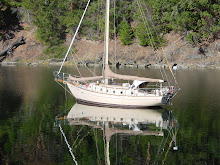La Mona, Bahia de los Angeles, BC, Mexico
After a few days parked just off of the village of Bahia de los Angeles, we have moved some 5 miles south to the SE corner of the bay, a beach known as La Mona. It is much quieter here, without the local pangas zooming back and forth past us at all hours of the day and night. A couple of mornings by the village, particularly on Sunday morning, we found ourselves surrounded by fishing boats, trolling and casting for bait before heading out to deeper water to catch bigger prey - a little disconcerting for Susanne who was sleeping in the cockpit and awoke to find a couple of local pangas filled with fishermen watching her from a few feet away.
The highlight of our stay by the village was a visit by some whale sharks. There were 3 of them slowly cruising around the boats at anchor, with some tourist boats following them and jumping in the water to swim with them. These fish are about 15 to 20 feet long and are mostly mouth. They just swim very slowly along at the surface of the water with their mouth wide open, to catch the tiny organisms that keep them fed. They are absolutely magnificent to see up close. After all of the local boats and tourists had left, one of the sharks came by our boat several times and actually collided with our dinghy (which was tied on behind and was swinging around with us as we were sailing around our anchor in a light wind at the time). I got some great pictures but was not able to post them as what internet connection we previously had, had now gone away.
Here in La Mona there is only one other boat currently at anchor, so we have the place pretty much to ourselves. Being at the end of the large bay, it would appear to be very exposed from the NW, but so far the only winds we have seen have been from the East and NE and we have not had any problem. The winds are very welcome here too as it is very hot and humid. We hit a high of 41C a couple of days ago, although it has been much cooler since - normally around 37 or 38 as a high, dropping to around 30 at night. Yesterday we took the dinghy to shore, along with our pump - it seems that the poor thing is losing some of its integrity in the sun, especially the high-pressure inflatable floor. I pumped it back up but it most likely will not last. Note: Most of the cruisers we have met down here refer to their dinghies as "deflatables"; I wonder why?
The marine life here at La Mona has been spectacular. We had a large pod of dolphins passing back and forth past our boat most of the day yesterday, hunting for food we assume. There are a couple of whale sharks that are cruising around, but have not gotten very close to us as yet. And there are quite a few rays of some kind that leap out of the water and do acrobatic tricks in the air - we have no idea why, but they do put on quite a show. At night the phosphorescence of the water is incredible - the fish darting all around and leaping out of the water make for a sort of fireworks display on the surface - we sat and watched this for a long time last night. All and all, this is our favorite anchorage in the BLA area so far.
{GMST}28|54|N|113|29.5|W|Playa La Mona, BC, Mexico|Playa La Mona, BC, Mexico{GEND}






























